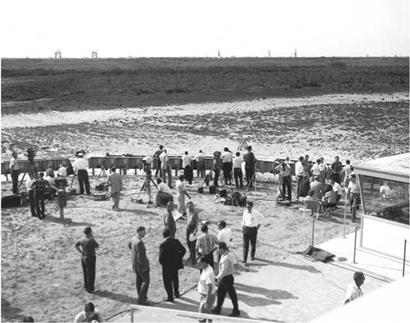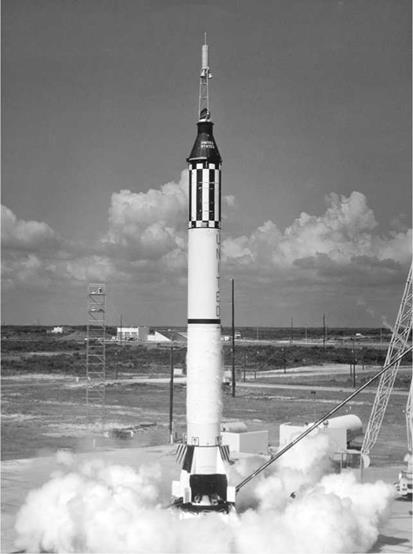LIFTOFF!
Inside Freedom 7, Shepard noticed when the umbilical tower connection which fed power and air into the spacecraft detached. This cut direct-line connections between the blockhouse and the booster and spacecraft, which were now operating on internal power. Instead, Freedom 7 began feeding radio telemetry information. The periscope was retracted electrically and a small door sealed the aperture. Shepard reported this, along with readings on the main bus voltage and current. “I had the feeling somehow that maybe I would’ve liked a little more over RF [radio frequency communications] with respect to the booster countdown steps,” he later pointed out [1].
Down along the causeways and beaches, and lining the roads and highways, half a million people were present to witness history, ready to watch and wonder and shout and scream encouragement, as perfectly described in the book Moon Shot. “In Cocoa Beach, people left their homes to stand outside and look toward the Cape. They went to balconies and front lawns and back lawns. They stood atop cars and trucks and rooftops. They left their morning coffee and bacon and eggs in restaurants to walk outside on the street or on the sands of the beach. They left beauty parlors and barber shops with sheets around their bodies. Policemen stopped their cars and got out, the
C. Burgess, Freedom 7: The Historic Flight of Alan B. Shepard, Jr., Springer Praxis Books, DOI 10.1007/978-3-319-0П56-1_5, © Springer International Publishing Switzerland 2014
|
|
As dawn gathered on 5 May, the media once again stood ready to record the launch of Freedom 7. (Photo: NASA)
|
|
In the Pad 5 blockhouse Wernher von Braun (center, wearing glasses) prepares to watch the launch. (Photo: NASA)
better to see and hear. Along the water, the surfers ceased their pursuit of the waves and stood, transfixed, swept up in the fleeting moments.” [2]
During the final minute, Shepard recited to himself, “Deke and the man upstairs will watch over me. So don’t screw up, Shepard. Don’t screw up. Your ass is hauling what’s left of your country’s man-in-space program!” He was reasonably calm as the count approached zero. His left hand automatically closed over the single-twist abort handle and he kept his right hand free, ready to start the clock on the control panel.
As the countdown passed into the final ten seconds, Slayton’s calm, professional countdown was accompanied by a little vibration as the Redstone’s internal pumps burst into life.
“T-minus seven,” Slayton intoned.
“Six, five…”
Shepard instinctively pushed his feet firmly against the capsule’s interior, bracing himself for the launch. He reached up and pressed a ‘ready’ button that illuminated a light on Flight Director Kraft’s console over in the Mercury Control Center.
“Four, three, two…”
He was conscious of his left hand gripping the abort handle. The escape tower’s pyrotechnics were armed and ready in case he had to suddenly and explosively tear Freedom 7 from the Redstone and a potential pad catastrophe.
Then, suddenly, it was T minus zero and time to go. This was the moment of truth for Alan Shepard. Two years of training had culminated in the naval aviator being strapped into a cramped capsule atop a modified missile and on the verge of making history.
At 9:34 a. m., he heard Slayton’s cry of “Ignition!”
Then he was absorbed by the stupendous task at hand. “I remember hearing [the] firing command, but it may very well be that Deke was giving me other sequences over RF prior to main stage and liftoff [so] I did not hear them. I may have been just a little too excited.” [3]
Within the thick walls of the Pad 5 blockhouse, former Peenemunde engineer Dr. Kurt Debus was directing the countdown along with Wernher von Braun, surrounded by members of the firing team. Although no one was directly responsible for pushing a button to launch the Redstone rocket, two members of the team had to commit to crucial roles. First was John (‘Jack’) Humphrey, who was responsible for pressing a launch sequencing button that issued the firing command. Then there was another of the Peenemunde engineers, Albert Zeiler. His critical, principal task was to watch the foot of the Redstone at the moment of ignition with his finger poised above an abort button. If he saw anything untoward in the color and shape of the exhaust issuing from the booster, and sensed the possibility of danger, he could press the button and instantly shut down the launch. With nothing amiss, Albert Zeiler gratefully moved his finger away from the dreaded abort button.
On board Freedom 7, Shepard’s heart rate had temporarily shot up to 120 beats a minute. “Rumbling far below,” he recalled later on. “Pumps spinning, fuel gushing through lines, joining in the combustion chamber. Before I could think about what came next, a dull roar boomed through the Redstone, rushed into the spacecraft and shook it with a surprisingly gentle touch. Thunder grew, louder and louder. ‘Liftoff!’ Deke called. I felt movement.
|
The moment of ignition, as mission MR-3 gets under way. (Photo: NASA) |
“At liftoff I started a clock-timer and prepared for noise and vibration. The time – zero relays closed properly, the on board clock started properly, and I must say the liftoff was a whole lot smoother than I expected. Again I readied myself for vibration and shock. In anticipation, I’d already turned up the volume of the headphones. I didn’t want to miss a word from Deke because of the still-increasing noise.
“‘Freedom 7 swayed slightly. My heart pounded.
“‘You’re on your way, Jose!’ Deke shouted.” [4]

|
On the beaches and roadsides and every other possible vantage point, the throngs who were there that historic morning had moments earlier been shielding their eyes from the glare of the rising Sun. They now stood transfixed – almost stunned – as the Redstone slowly rose off the pad. There were loud cheers, shouts of encouragement and applause. When a loud crackling thunder swept across the Cape, the cheers grew ever louder as Alan Shepard was launched into the sky on board a spacecraft named Freedom 7.













